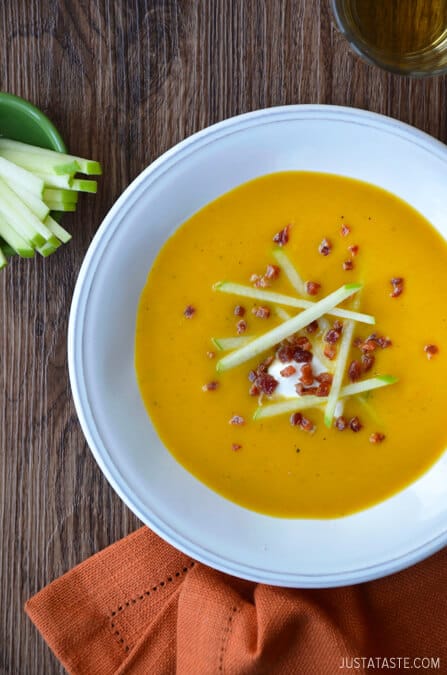Apple Crisp
Just about any grocery store including the big box carry a little red cardboard box in the fruit section by the apples with "Apple Crisp" on the package. I bought a pack of this a few weeks ago and made it, and although it was delicious, I realized I had essentially paid $2 for a paper packet of a few spoonfuls of sugar. Buy it if you don't have the staples on hand and you just want to slice apples and go. Here's how to make it from scratch:

6 apples, peeled and sliced (choose your sugar content wisely, as the crumb topping will add extra sweetness. Crisp Galas are my favorite and I didn't find them to be too sweet in this, but if you like a tart contrast, choose Granny Smiths. In any case, choose an apple that has a crisp bite, not a soft apple like a Red or Golden Delicious, as they won't stand up to the heat of the baking)
6 tbl white sugar
1/3 c brown sugar
3/4 c flour
1 tsp cinnamon
6 tbl butter, cut into small pieces
Preheat oven to 400. Arrange sliced apples in baking dish. Cut dry ingredients into butter slices with 2 knives or use a pastry blender until a fine crumb forms. Sprinkle topping over sliced apples and bake for 30 minutes.
I haven't made this with pears but I imagine a sturdy pear like a Bosc or an Anjou would hold up to the heat well, especially mixed with the apples.
Roasted Carrots
Don't be tempted to use "baby" carrots for this recipe; they're usually carrots from the reject pile that have been shaved down to a miniature size, and typically too woody for cooking. Cut your carrots into as equal of a dimension as possible so that they cook evenly.
8 large carrots, peeled, cut into 3" matchsticks (split into halves or quarters lengthwise if necessary)
2 tbl melted butter, coconut oil or bacon fat
salt and pepper to taste
Preheat oven to 375. Toss carrots with melted fat and season to taste. Roast for 20-30 minutes.
Butternut Squash Soup
I hate peeling and chopping butternut squash and I especially hate going through all that work to find out that I haven't got enough squash to make a decent pot of soup. This is one of the few supermarket shortcuts I use--the pre-chopped butternut squash cubes, in clamshells in the produce department. Also, when a recipe calls for fresh herbs, I always buy a pot in the garden section at Whole Foods or Sprouts. Even at Home Depot 3" little herb pots run around $3 or less; in the grocery store clamshells a sprig of fresh herbs is $3.50. Even if I kill the plant in the pot I still spent less, and hopefully I managed to keep it alive at least til the next time I need that herb.

1 Butternut squash OR 4 cups chopped butternut squash cubes (2 clamshells)
1 yellow onion (chopped)
2 granny smith apples,peeled, and made into matchsticks.
6 cloves garlic (crushed)
16 oz broth (I use vegetable but chicken and beef work just as well)
4 tbl coconut oil or bacon fat (melted, divided)
fresh sage
salt
pepper
sriracha sauce (optional)
sour cream (optional)
bacon (optional)
Preheat oven to 400. Toss squash with 2 tbl fat and season with salt and pepper. Place on baking dish and roast for 40 minutes or until caramelized. Meanwhile, use a large heavy bottomed pot to saute onions in the rest of the bacon fat until translucent; add the garlic, 1 apple, 1 tsp of salt and 1 tsp of pepper and 6-8 fresh sage leaves. Cook for 2 minutes. Add broth. Once squash is cooked add squash to pot and stir. Allow to cool before putting through a blender in batches (do not fill to top as steam will cause to the top to fly off if the mixture expands too much). Garnish with the second granny smith apple matchsticks, and I like a couple dashes of sriracha, a dollop of sour cream, and a few crumbles of bacon on top.
Brussels Sprouts with Bacon
The only way I like bacon these days is baked in the oven (350 at 30 minutes on a rack over a roasting pan to catch the drippings). Baked bacon is so melt-in-your-mouth good you won't want anything else and it will ruin you for restaurant fried bacon. It's worth making up a batch to keep in the refrigerator and drain the drippings to use in cooking, but if you don't have a batch of baked bacon on hand, you can cut the slices into 1/2" sections and cook them quickly in a skillet.

4 cups brussels sprouts, halved, ends trimmed and tough outer leaves removed
2 granny smith apples, peeled and cubed
2 tbl melted bacon fat, butter or coconut oil
sea salt
pepper
balsamic vinegar
8 slices of bacon, cooked
Preheat oven to 375. Toss the brussels sprouts and cubed apples with fat and season with salt and pepper. Roast for 20 minutes or until crispy and caramelized. Sprinkle with balsamic and crumbled bacon.
Fall Vegetable Garden Soup
Fall Vegetable Garden Soup
Minestrone Alla Romagna (source: Essentials of Italian Cooking, Marcella Hagan)
1 lb fresh zucchini
1/2 c olive oil
3 tbl butter
1 cup thinly sliced onion
1 c diced carrots
1 c diced celery
2 cups peeled diced potatoes
1/4 lb fresh green beans
3 c. Shredded cabbage
1 and 1/2 c canned cannellini beans
6 cups meat broth
Optional: crust from 1-2 lb piece of parmigiano-reggiano cheese
2/3 c canned tomatoes with juice
1/2 c olive oil
3 tbl butter
1 cup thinly sliced onion
1 c diced carrots
1 c diced celery
2 cups peeled diced potatoes
1/4 lb fresh green beans
3 c. Shredded cabbage
1 and 1/2 c canned cannellini beans
6 cups meat broth
Optional: crust from 1-2 lb piece of parmigiano-reggiano cheese
2/3 c canned tomatoes with juice
1. Soak the zucchini in cold water for 20 minutes then rinse clean of grit. Trim on both ends and dice finely.
2. In a large stockpot add oil, butter, and onion and cook on medium low until onion is pale gold in color.
3. Add carrots and cook for 2-3 minutes. Then add celery and cook for 2-3 minutes, then add potatoes and do the same.
4. Snap off both ends of green beans and dice. Add to pot and cook for 2-3 minutes. Add zucchini and do the same. Add cabbage. Cook for 5-6 minutes.
5. Add broth, optional cheese, tomatoes and a sprinkle of salt. Cover pot lower heat and adjust to a steady gentle simmer.
6. Cook for 2.5 hours then add the cannellini beans, stir well and cook for 30 minutes more.
7. Remove the cheese crust, add grated cheese if desired, then taste and correct for salt.
2. In a large stockpot add oil, butter, and onion and cook on medium low until onion is pale gold in color.
3. Add carrots and cook for 2-3 minutes. Then add celery and cook for 2-3 minutes, then add potatoes and do the same.
4. Snap off both ends of green beans and dice. Add to pot and cook for 2-3 minutes. Add zucchini and do the same. Add cabbage. Cook for 5-6 minutes.
5. Add broth, optional cheese, tomatoes and a sprinkle of salt. Cover pot lower heat and adjust to a steady gentle simmer.
6. Cook for 2.5 hours then add the cannellini beans, stir well and cook for 30 minutes more.
7. Remove the cheese crust, add grated cheese if desired, then taste and correct for salt.
















